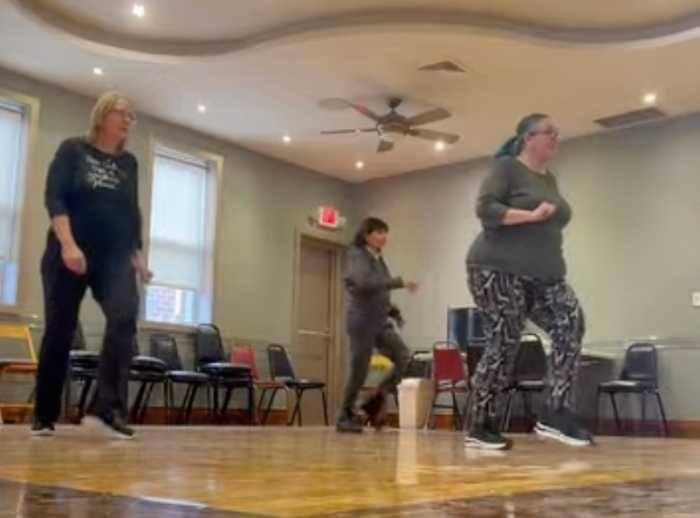A crowd of around 250 cheered in the Melrose Ballroom in Astoria on a recent night in what looked like a scene from “Game of Thrones” as armored combatants clashed, with swords clanking as metal hit metal.
Chants periodically broke out with the combatants’ fighting names, as two “combatants” brawled with swords, helmets and more than 40 pounds of armor while video cameras recorded and projected the fight, which unfurled in a ring surrounded by metal barricades with a net hanging from above.
Part sporting event, part spectacle, part medieval, part modern, part fighting, part fashion, this was not a scene from a TV show but from a type of New York night (or knight) life and combat, attracting crowds of hundreds to New York Night (or should that be knight) clubs.

The New York chapter of the Armored League (its logo is emblazoned on the fighting area) is the professional arm of an organization devoted to armored combat. The nonprofit Gladiators NYC teaches the sport and sponsors exhibitions behind the Metropolitan Museum of Art.
Fighters with names such as Jake “Hercules” Meddaugh,” Orlando “the Bronx Brawler” Mendez, Abeid “Mando” Mitchel, Orion “Starry Knight” Goodman (with a nod to Van Gogh), Jesse “Shortbread” Mooney, Russel “Stormrider” Geller, Parker “Outlaw” Robertson and Daniel “Green Dragon” Patton suited up and fought it out.
Strobe lights splash colors all over the club while pulsing music blasts with a heavy beat, shaking the floor before the battles begin.
“I’m a nerd. I play games like this. I used to play World at War,” said Julia Belyakova, who saw her first match at the American Dream Mall in East Rutherford, New Jersey. “I don’t like guns, but I like swords.”
Games of Thrones
Others fascinated by “Game of Thrones” and the Middle Ages, such as Adam Streff, a software engineer, found about the event on Instagram and went out of curiosity.
“I’ve never seen a medieval duel before, so I wanted to see it,” Streff said. “They seem like they’re trying their best.”

Jordan Gipson, who works in marketing, said he was also fascinated by “Game of Thrones” and medieval fighting beyond armor displays in museums.
“I think the worlds are immersive, the stories are engaging,” Gipson said of the shows. “I got into it while I was watching. I thought about it, read about, watched videos. It’s finished now.”
Game of Thrones may have run its course, but “armored combat” bouts are catching on at clubs. Alma Francois-Pijuan, who went to free armored combat classes at a community center and now helps at events and trains, watched as part of a crowd of several hundred.
“I didn’t know stuff like this was possible. I dreamed about it. Now I see it in real life,” she said. “I’m learning how to fight. I’m practicing and training. People who’ve been doing this for a while fight professionally.”
Show business
Hundreds filled two levels of the Melrose Ballroom with tickets ranging from $35 for general admission to $100 for ringside at the latest match.
“Are you ready?” the emcee shouted at this night club turned fight club for a sport, not a scripted show. “I need to hear some roar in this building. Are you ready? Warriors, please enter the arena.”

In one bout, Outlaw, with a white skull image on his back, ran his sword along the metal barriers, clanking as it went. Green Dragon, with a green dragon on his back, rushed forward, as the two parried and pushed, heads butting.

“It’s been a long time that we’ve been working on this,” said Damion DiGrazia, CEO and founder of the New York chapter of the Armored League. “I love that it’s getting to the level it’s at now.”
Building interest
Although many people are discovering armored combat now, DiGrazia has been working to build this sport and league for more than a decade.
“When I first got into this, I was working on Wall Street at Morgan Stanley,” DiGrazia said. “I found out about this sport when I was into extreme sports.”
He said he spent $10,000 on armor and began fighting around the country 12 years ago, before starting his own matches.
“I traveled around the world fighting. I started my own fight club in New York in a basement in Harlem. It grew from that,” DiGrazia said. “Twelve years later, here we are. They say it takes ten years to become an overnight success.”
Military veterans, Ph.D. candidates and bouncers battle in up to 80 pounds of armor and blunted weapons in the league.

“The crowd is getting to know who the fighters are,” said Alec Meeker, the league’s chief commercial and growth officer. “They have their favorites. They chant their favorite fighter’s name. The production values are higher.”
Meeker likes the fact that some audience members don medieval garb, turning the sport into a scene. “They dress up in amazing medieval-inspired outfits and really get into the spirit of the event, creating a collective energy you won’t find anywhere else,” Meeker said.
Not the Renaissance Faire
Dressed formally like a host, DeGrazio smiled occasionally at fighters whose smiles were sometimes visible behind steel.
“This is where the grit of ancient warfare meets the glamour of modern New York culture,” Meeker said. “Think of it as a blend of MMA-style striking and grappling with the strategy and spectacle of medieval history. This isn’t a Renaissance Faire show; it’s a genuine athletic competition of skill, strength and endurance.”
Both said safety is paramount, while noting this is a contact sport with rules and referee designed to protect combatants. “We try to mitigate risk,” DiGrazia said.
Meeker noted that weapons are blunted and not legally considered weapons as they seek to build a modern sport with shades of the Middle Ages.
“For a long time, different organizations have used slightly different rule sets, which has held the sport back from its full potential,” Meeker said. “We are actively working to create a national set of rules.”
Meeker said “every fighter’s equipment is meticulously inspected by our marshals before a match” and that their “mission is to professionalize the sport.”
They hope that their Armored League will be sanctioned by the New York State Athletic Commission.
Fighters are independent contractors paid through contracts who fight to win based on points awarded.
“The fighter with the highest score at the end of a round wins that round, and the fighter who wins the most rounds wins the match,” Meeker said.

Many people involved in armored combat see it as reaching critical mass. “I enjoy the thrill, the challenge, the fun,” Pijuan said. “It has been getting bigger. There’s more hype to it.”
Gipson said he felt one fighter, who lost based on scoring, should have won, but scored sports can be unpredictable. “I think Outlaw should have won that fight. I thought he was dominating,” he said. “It seems physically intense. They’re really battling.”
There’s another bout in the works for Oct. 16 at 3 Dollar Bill in Brooklyn. The winner of the latest tournament, Abeid, was entered in an international fighting tournament on Nov. 20.
DiGrazia, meanwhile, hopes to grow the sport and spectacle, enjoying the crowds cheering fighters and the spectacle he created.
“This is one of the best attended events we’ve had,” DiGrazia said. “I was standing there. Someone said, ‘That’s our guy we were rooting for last time.’”






































